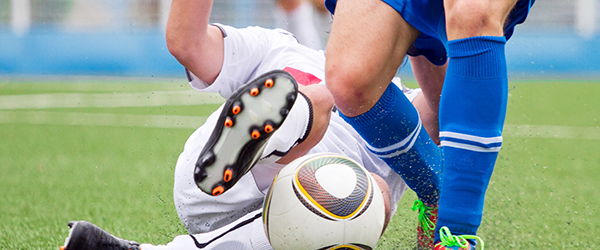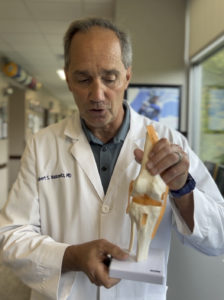Have an ACL-related injury? Here’s what you need to know.

Written By, Robert Waskowitz, MD

For many, an ACL injury can significantly change the way we go about our lives. It could be a career changer or season-ending injury for an athlete or affect someone’s regular quality of life. I can attest to it because I’ve been on that side. I’ve torn both my ACLs. One playing basketball and the other while ski racing. Having gone through an ACL injury and rehab, I am able to connect with my patients and help them through the same process.
What is the ACL?
The Anterior Cruciate Ligament (ACL) is one of the main ligaments that help stabilize and support the knee joint. It connects the thighbone, the femur, to the shinbone, the tibia. It controls the rotation and translation of the two bones together.
How does an ACL injury occur?
Most ACL injuries happen in sports involving sudden stops and direction changes, such as football, basketball, soccer, tennis, and volleyball.
- Suddenly slowing down and changing direction (plant and cut)
- Pivoting with your foot firmly planted
- Landing from a jump incorrectly
- Stopping suddenly
- Rarely as a result of a direct blow to the knee
Most people feel pain and hear a pop when the injury happens. But after the pain and swelling go down, a person can walk, go up and down stairs, and even jog in a straight line. The knee will feel unstable and will likely give out. The problem with an ACL injury is once you damage it, it can’t heal on its own, which impacts your performance and quality of life.
What are the treatment options?
Usually, for a partial injury to the ACL ligament, the treatment involves allowing the ligament to heal on its own. However, a fully damaged ligament requires surgery to repair it.
During an ACL reconstruction surgery, an orthopedic surgeon removes that damaged ligament and replaces it with a graft tendon from another part of the knee or a donor. The reconstruction gives the patient stability and that sense of performance back.
ACL reconstruction surgery is an outpatient surgery but is still considered a major procedure, and the road to recovery can be long.
On the road to recovery
Having experienced this injury and recovery process twice, I have the unique opportunity to place myself in my patient’s shoes and understand what they are going through. Being injured is a challenge, and the best thing we can do for our patients is to listen to them and support them throughout treatment and recovery.
Rehab is just as important as surgery, and our patients must be committed to working toward regaining motion, strength, and stability in their knees. We’ll get you paired with one of our fantastic physical therapists at OAH, and they will teach you exercises that over time will increase the strength in your knee.
Usually, patients can begin to walk without crutches after a few weeks of rehab. Following the rehabilitation plan is important for proper healing and achieving the best possible outcomes.
How to prevent an ACL injury
Keeping the range of motion in your knee is key. If there’s stiffness in a joint, work on a flexibility program. Motor power and strength are equally as important. Work on strengthening the quadriceps, hamstrings, and calf muscles through any moderate to low-impact activity such as walking, biking, or swimming.
Have an ACL-related injury?
If you’ve experienced an ACL-related injury, either recently or in the past, our team of sports medicine specialists at OAH will work with you to diagnose your injury and put together a treatment plan. Our goal is to get you back to normal physical function so you can Make Your Move.